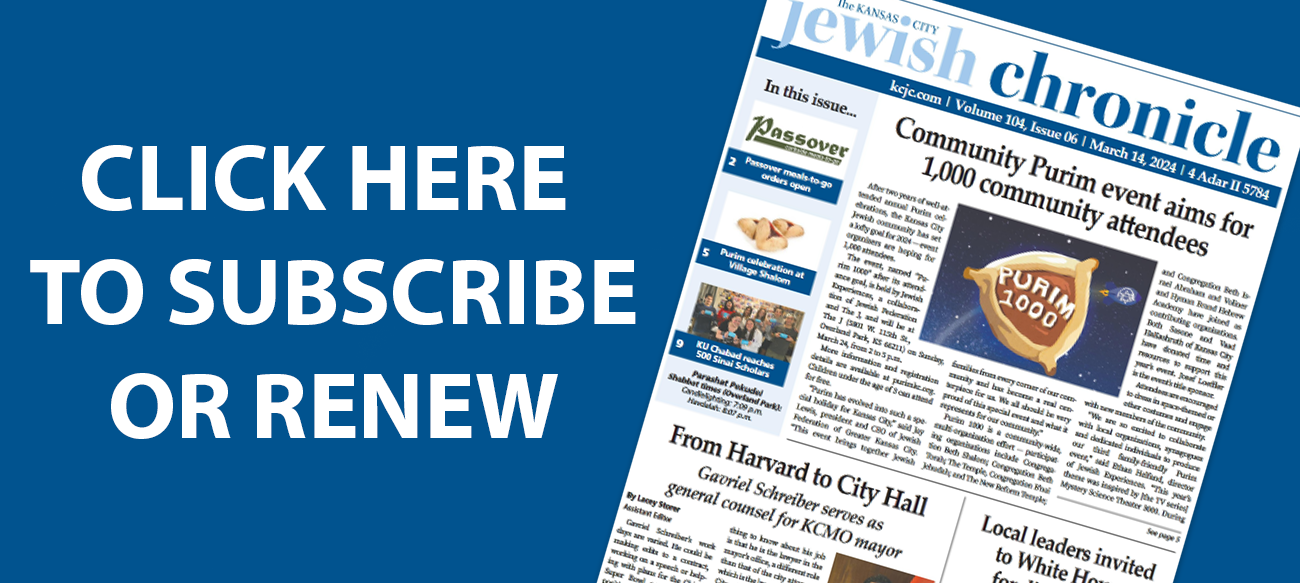More than 100 people filled the White Theater on Sept. 14 to mark the Jewish Community Foundation of Greater Kansas City’s first Foundation for Our Future event in four years.
They gathered to renew their commitment to community-wide planned giving, to honor the newest donors to be inscribed in the Endowment Book of Life, and to celebrate the millions of dollars of bequests that will sustain local institutions for future generations.
Food — eating and enduring — was the explicit theme. The reception blended Jewish culinary traditions, from flown-fresh-from-New-York H&H bagels with lox and cream cheese, to za’atar roasted vegetable skewers and Persian jeweled rice, to a signature cocktail: the “Mani Eddy” (essentially a Moscow Mule with a splash of rosemary simple syrup and a spritz of concord-grape Manischewitz).
The evening culminated with a presentation by Dr. Jordan Rosenblum, a Jewish studies professor at the University of Wisconsin-Madison, who offered up “The Dish on Jewish Food & Culture,” with insights into his research on food customs and Jewish identity.
“Our food traditions are often one of the most meaningful ways we share our history with future generations and create lasting family memories,” said Frank Lipsman, president of the Foundation’s Board of Trustees, as he welcomed the crowd to an event twice postponed by the pandemic. “The fact that we are finally together makes this evening that much more special.”
Lipsman emphasized that the Foundation’s mission, since its establishment in 1959, has always been to encourage gifts and investment to ensure the viability of the Jewish community and its institutions, regardless of the economic climate or changing needs.
In recent years, this has included a focus on planned giving — the process through which donors commit a portion of their estates to philanthropy — from the Bushman Community Endowment Program to its current successor, the Create a Jewish Legacy program, which provides planned giving training and consulting services, along with financial incentives for donors and agencies.
Through such efforts, the Foundation has secured nearly $100 million in future planned gift commitments from more than 900 donors. Another $74 million has already been realized, helping to support 18 congregations and organizations in Kansas City, Lawrence, and Topeka.
Those who commit $10,000 or more to the permanent endowment of a Jewish agency or synagogue are invited to add their names, photos, and memories to the Endowment Book of Life.
“It is full of meaningful stories and remembrances of love, connection, and personal inspiration,” said Executive Director Lauren Hoopes. “Presented in its pages is an ever-growing collective portrait of our Jewish community and a testament of commitment to ensuring its future.”
Hoopes introduced a video in which Martha Gershun spoke of her late mother Gloria’s decision to endow gifts to organizations such as CASA, Jewish Federation of Greater Kansas City, and Congregation Beth Torah. Since its introduction in 2003, more than 280 people have signed the Book. That evening, 14 more individuals, couples, and families added their own pages.
Hoopes and Josh Stein, JCF Director of Philanthropy, invited each signee on stage and shared excerpts from their entries.
“It is our hope that our gifts will ensure that our community will continue to thrive and grow Jewishly,” Karen and Jeffry Gerson wrote.
Michael Staenberg reflected on his first childhood memory of charitable giving, after he had performed chores to earn $10 for a coat he wanted to buy.
“I finished the work and my dad pulled out ten $1 bills and put them on the table and said, ‘Well the first thing we’re going to do is take out a dollar for the synagogue.’ Tzedakah is first,” he said.
The ceremony concluded with a brief moment of silence for the 17 Book of Life members lost since the last signing in 2018.
The theme of food and legacy continued throughout the evening. Lipsman related how a Jewish cookbook kept his extended family connected during COVID, as every week siblings and cousins would share photos of the challahs, babka, rugelach, bagels, or hamantaschen they had just baked. Hoopes recalled her mother as “a militant non-cook” who used an oven for storage — yet indirectly inspired Hoopes to stock her own kitchen with “every spice, butter, oil, and gadget imaginable,” and to use them all.
Professor Rosenblum described “the long and venerable history of Jews using food as a means to express both longing and belonging... Like food, these stories are sometimes sweet, and sometimes bitter; sometimes savory, and sometimes sour; and sometimes simultaneously sweet and sour.”
He shared two examples: The notorious 1883 “Terefah Banquet” at Cincinnati’s Hebrew Union College featured oysters — Rabbi Isaac Meyer Wise called them “ocean vegetables” — but pork was still taboo. A couple decades later, when the price of kosher meat in New York skyrocketed, actual riots broke out, mostly lead by Lower East Side balabustas. Both stories, he said, illustrated how different American Jews used their relationship to food to connect to their conception of Jewish legacy — just as we still do. “When we ate those delicious foods before this talk, we symbolically ingested our identity alongside fat, protein, and fiber,” Rosenblum said.
On the way out, guests were given apple-and-honey cupcakes for a sweet new year to mark a moment that connected the past to the future.
Contact Josh Stein for more information about planned giving at (913) 327-8121 or .



